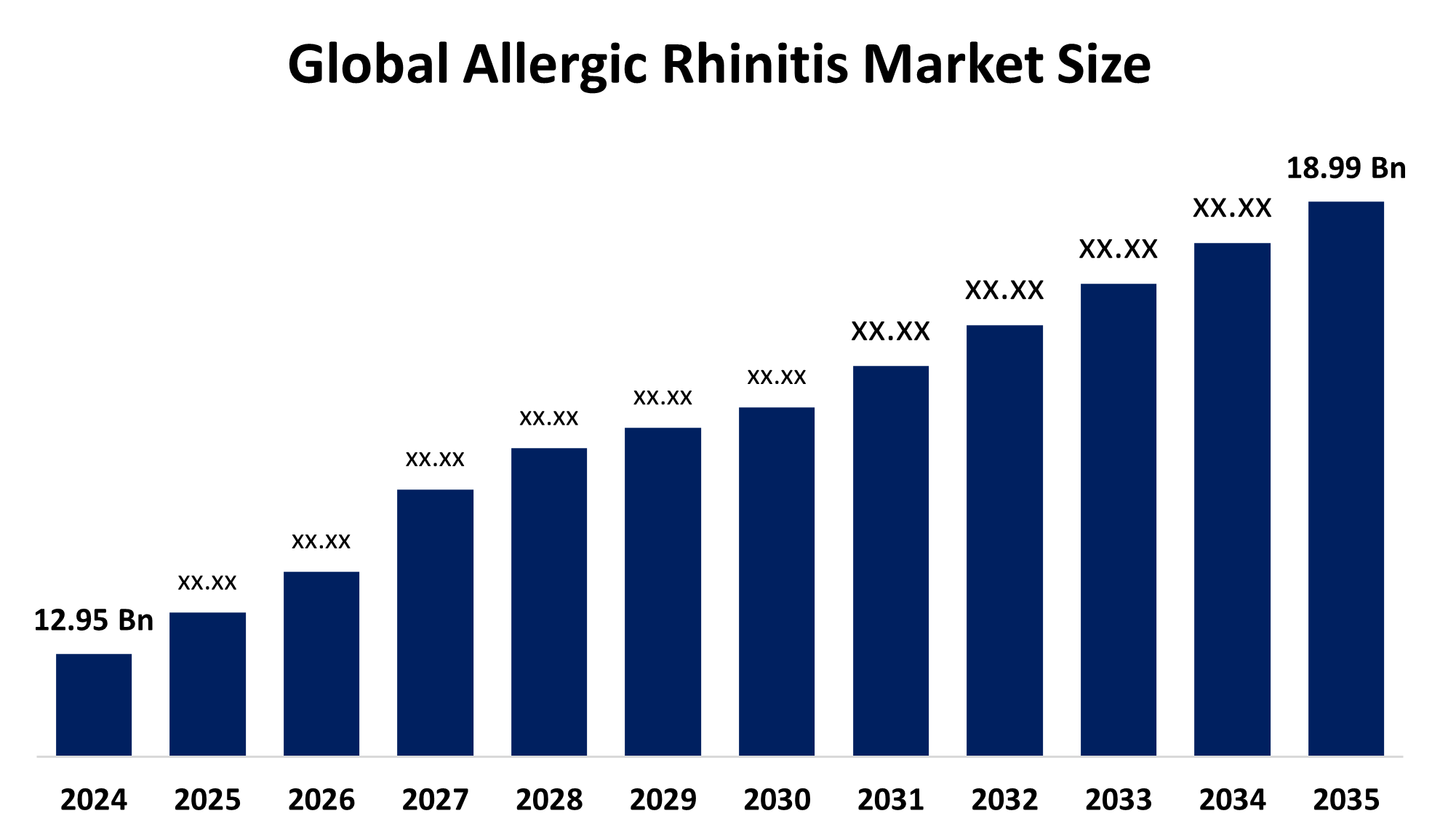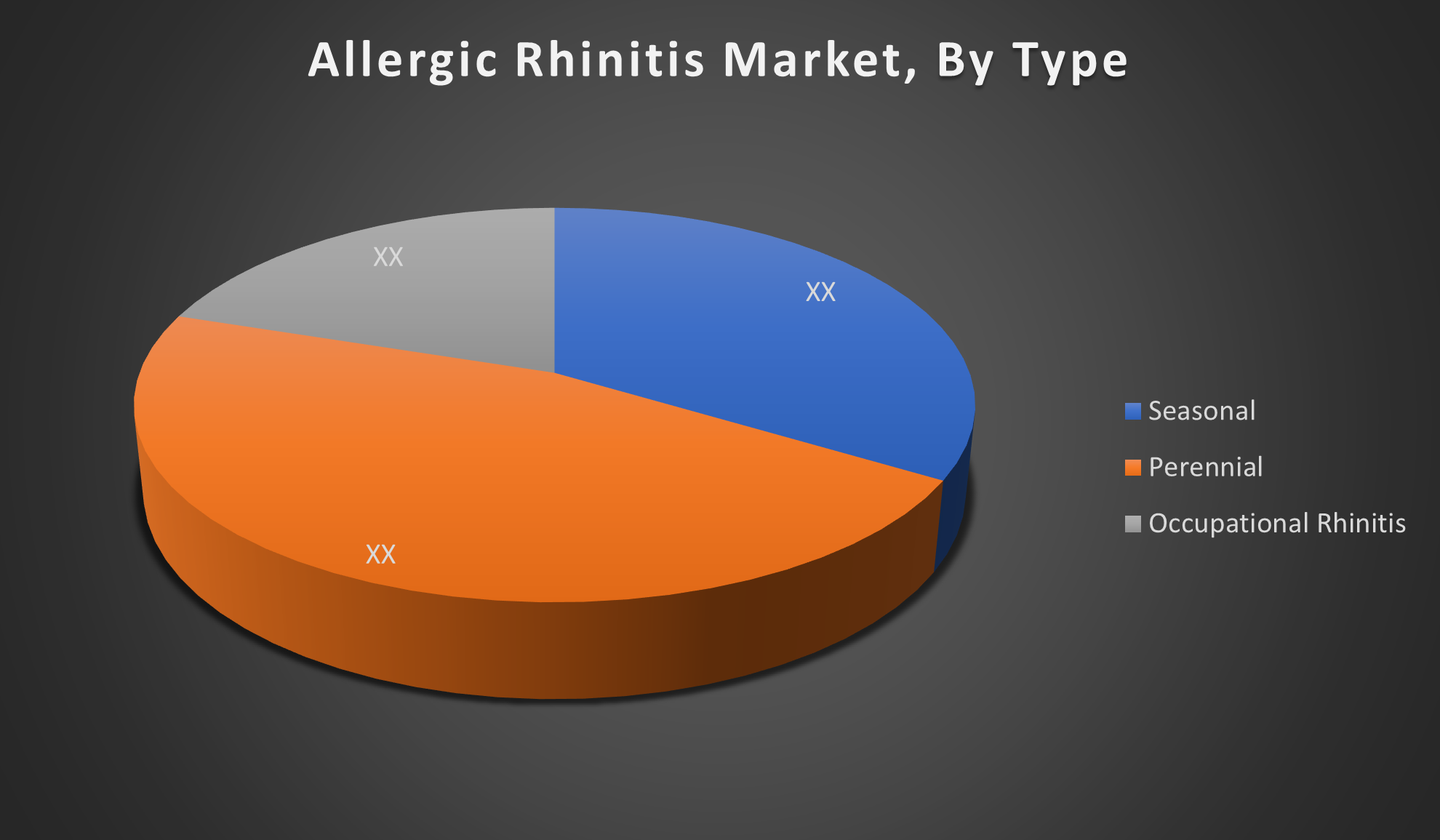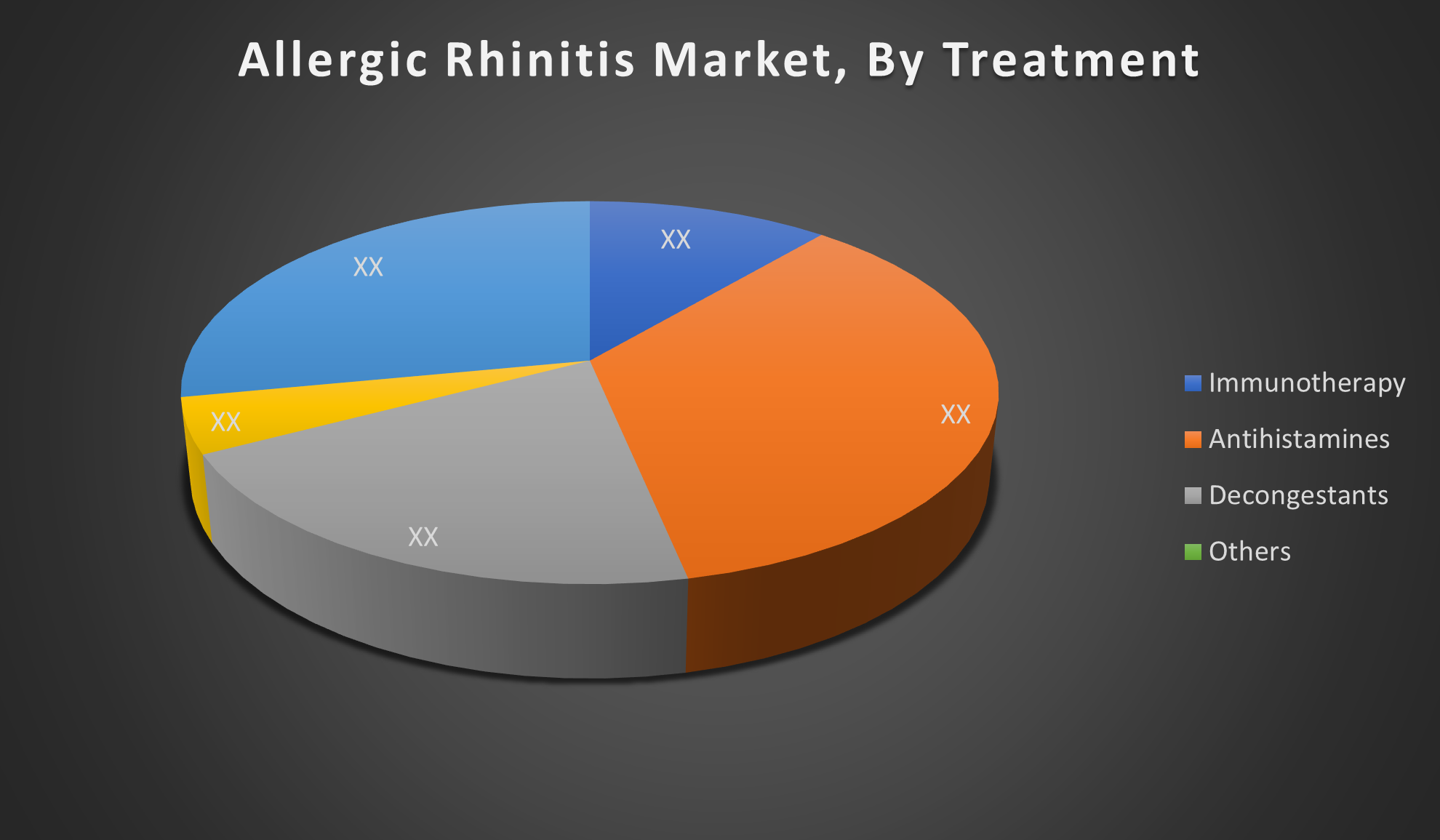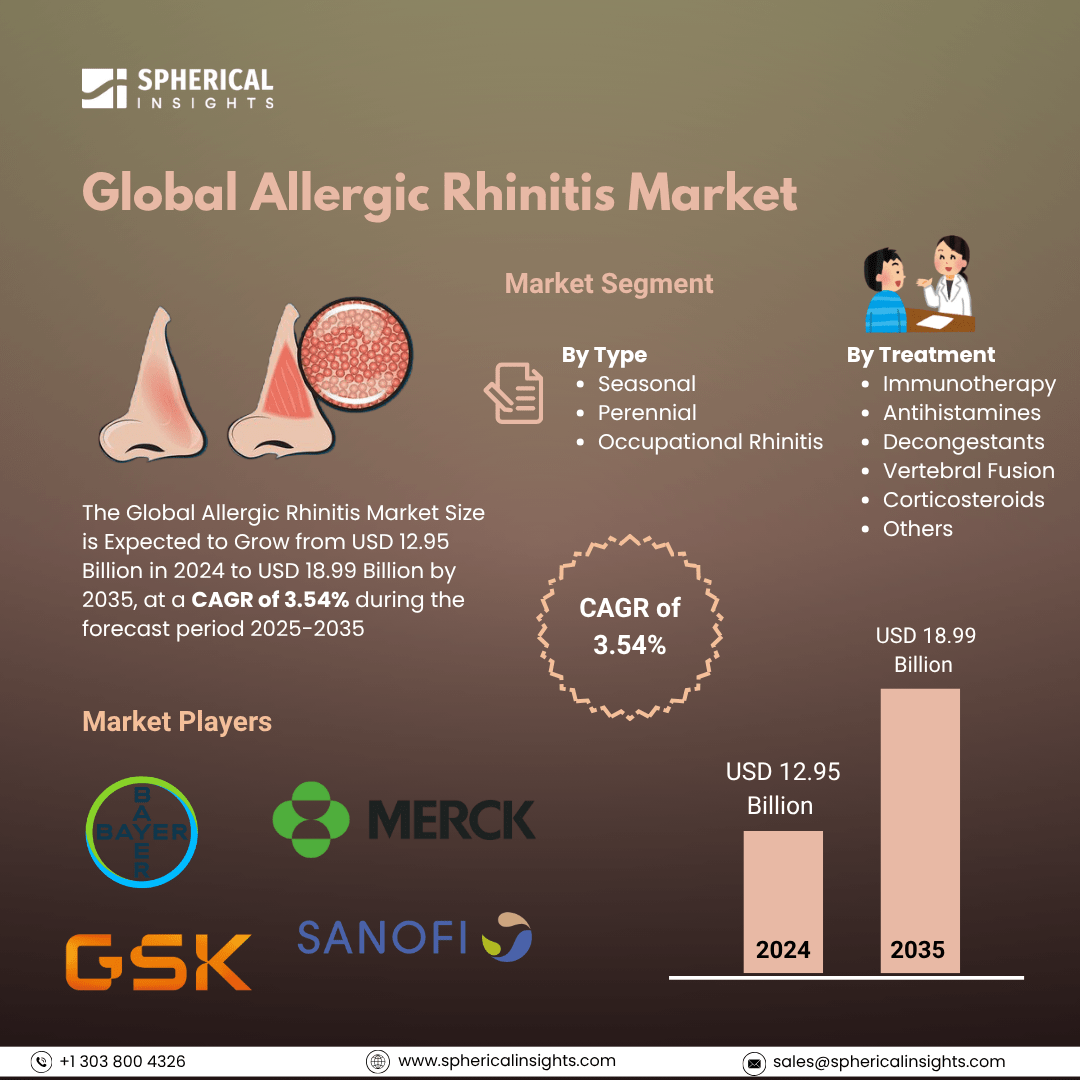- As per Spherical Insights & Consulting, The Global Allergic Rhinitis Market Size is expected to Grow from USD 12.95 Billion in 2024 To USD 18.99 Billion by 2035, at a CAGR of 3.54% during the forecast period 2025-2035, owing to the launch of new therapies in the market and the rise in the number of cases.
- The leading Allergic Rhinitis Market Companies such as Bayer, GlaxoSmithKline, Sanofi, Merck & Co., Johnson & Johnson, Teva Pharmaceutical Industries, Novartis, Boehringer Ingelheim, AstraZeneca, Viatris, Dr. Reddy’s Laboratories, Glenmark Pharmaceuticals, ALK-Abelló, Stallergenes Greer, Allergy Therapeutics, and Others.

Allergic Rhinitis Treatment Market: Understanding and Treatment Algorithm:
Allergic rhinitis is an allergic reaction that occurs when the immune system overreacts to allergens like pollen, dust mites, or pet dander. It causes symptoms such as sneezing, runny nose, nasal congestion, and itchy eyes. It can be seasonal or year-round and is often treated with antihistamines or nasal sprays.
Allergic Rhinitis Diagnosis:
Diagnosis of allergic rhinitis involves reviewing medical history, symptoms, and conducting a physical exam. Doctors may use skin prick tests or blood tests to identify specific allergens. Nasal endoscopy or imaging may be used in complex cases. Accurate diagnosis helps determine triggers and guide effective treatment or allergen avoidance strategies.
Allergic Rhinitis Treatment
Treatment of allergic rhinitis includes avoiding known allergens and using medications such as antihistamines, nasal corticosteroids, and decongestants to relieve symptoms. In more severe cases, immunotherapy (allergy shots or sublingual tablets) may be recommended. Lifestyle changes, like using air purifiers and frequent cleaning, can also help manage the condition effectively.
Allergic Rhinitis Epidemiology
The disease epidemiology covered in the report provides historical as well as forecasted epidemiology segmented by Total Diagnosed Incident Population of Allergic Rhinitis, Gender-specific Diagnosed Incidence of Allergic Rhinitis, Type-specific Diagnosed Incidence of Allergic Rhinitis, Age-specific Diagnosed Incidence of Allergic Rhinitis, Diagnosed Incident Population based on Primary Site of Allergic Rhinitis, and Diagnosed Incident Population based on Histologic Classification of Allergic Rhinitis Tumour in the global market covering North America, Europe, Asia-Pacific, Latin America, the Middle East, and Africa from 2024 to 2035.
Principal Insights
This section offers a global overview of allergic rhinitis epidemiology in major markets worldwide.
Country Wise- Allergic Rhinitis Multiforme Epidemiology
- The epidemiology segment provides Allergic Rhinitis prevalence data and findings across key regions worldwide, including North America, Europe (Germany, France, Italy, Spain, and the United Kingdom), Asia-Pacific (including Japan), Latin America, the Middle East, and Africa.
Allergic Rhinitis Recent Developments:
- In April 2021, ALK-Abelló announced that the FDA had approved an expanded label for RAGWITEK, a short-ragweed pollen allergen extract tablet. This approval allowed its sublingual immunotherapy to be used in children and adolescents aged 5–17 for ragweed-induced allergic rhinitis, with or without conjunctivitis.
Allergic Rhinitis Marketed Drugs:
Flonase (fluticasone propionate) is a corticosteroid nasal spray that reduces inflammation in the nasal passages. It is FDA-approved for the treatment of seasonal and perennial allergic rhinitis in adults and children aged 4 and older. It is available over the counter and widely used for daily symptom control.
Nasonex (mometasone furoate) is a prescription corticosteroid nasal spray used to treat nasal symptoms of allergic rhinitis. It works by reducing inflammation and allergic responses in the nasal passages. It is FDA-approved for use in adults and children as young as 2 years for seasonal and perennial allergies.
Dymista is a combination of azelastine (an antihistamine) and fluticasone (a corticosteroid) in a nasal spray formulation. It is FDA-approved for the relief of seasonal allergic rhinitis symptoms in patients 6 years and older. It offers faster and more complete symptom relief than either drug used alone.
Allergic Rhinitis: Emerging Therapies
- BNT327: It is a bispecific antibody in late-stage trials for allergic rhinitis. It targets two immune checkpoints to modulate the immune response, aiming to reduce allergic inflammation and improve symptom control in patients who do not respond adequately to current therapies.
- Tezepelumab: It is a monoclonal antibody targeting thymic stromal lymphopoietin (TSLP), a key cytokine involved in allergic inflammation. It is in late-stage clinical trials aiming to reduce symptoms of allergic rhinitis and asthma by preventing early immune system activation.
- Eblasakimab: It is an investigational monoclonal antibody that blocks the interleukin-13 receptor alpha-1 (IL-13Rα1). It is being evaluated for allergic rhinitis treatment by reducing inflammation and allergic responses mediated by IL-13 and IL-4 pathways.
- Vazegepant: It is a novel CGRP receptor antagonist initially developed for migraine, currently being studied for allergic rhinitis to alleviate nasal congestion and inflammation through modulation of neurogenic inflammation.
Allergic Rhinitis Market Outlook
- The allergic rhinitis market includes the development, production, and sale of drugs and therapies designed to prevent and treat allergic rhinitis—a condition causing nasal inflammation due to allergens. The market covers medications, immunotherapies, and devices targeting symptom relief and long-term allergy management.
- Key drivers of the allergic rhinitis market include rising allergy prevalence, increasing pollution, growing awareness of treatment options, advancements in immunotherapy, and expanding healthcare access. Additionally, the demand for effective, non-invasive therapies and over-the-counter medications fuels market growth globally.
- Opportunities in the allergic rhinitis market arise from the development of novel biologics, personalized immunotherapies, and advanced delivery systems. Emerging markets, increasing patient awareness, and growing investment in allergy research also offer potential for expanding treatment options and improving patient outcomes worldwide.
- Global government initiatives have focused on enhancing allergic rhinitis care through integrated care pathways (ICPs), increased access to immunotherapy, and public awareness campaigns. For instance, Germany has adapted the ARIA guidelines to its health system, while the UAE has issued consensus recommendations on allergen immunotherapy for managing allergic rhinitis.
- Market challenges include high treatment costs, limited patient awareness, side effects of medications, and lack of standardized diagnosis methods, which hinder widespread adoption of advanced therapies.
- The allergic rhinitis market is projected to grow due to increasing allergy prevalence and rising demand for effective, innovative treatments worldwide.
Allergic Rhinitis Market Segmentation
By Type:
- Seasonal
- Perennial
- Occupational Rhinitis

Perennial Allergic Rhinitis (PAR) holds the largest market share because it causes year-round symptoms due to constant exposure to indoor allergens like dust mites, pet dander, and mold. This chronic condition leads to continuous treatment needs, driving higher demand for medications and therapies compared to seasonal forms.
By Treatment:
- Immunotherapy
- Antihistamines
- Decongestants
- Vertebral Fusion
- Corticosteroids
- Others

The Antihistamines segment holds the largest share in the allergic rhinitis treatment market due to their widespread availability, fast symptom relief, and over-the-counter accessibility. Their effectiveness in managing mild to moderate symptoms drives high patient preference, making them the most commonly used treatment compared to immunotherapy and corticosteroids.
Regional Segment Analysis of the Allergic Rhinitis Market
North America holds the largest share in the allergic rhinitis market due to its advanced healthcare infrastructure, high awareness levels, and widespread access to over-the-counter and prescription medications. The region also benefits from a well-established pharmaceutical industry, high allergy prevalence, early diagnosis practices, regular physician visits, and consistent use of immunotherapy and corticosteroid treatments for long-term symptom management.
Asia-Pacific is the fastest-growing region in the allergic rhinitis market. This growth is driven by rapid urbanization, rising pollution levels, increasing healthcare spending, and greater awareness of allergy-related conditions. Additionally, increasing investments in healthcare infrastructure, expanding patient access to allergy medications, lifestyle changes, and growing clinical research activities in countries like China, India, and South Korea are further accelerating market expansion.
Allergic Rhinitis Market Key Companies
- Bayer
- GlaxoSmithKline
- Sanofi
- Merck & Co.
- Johnson & Johnson
- Teva Pharmaceutical Industries
- Novartis
- Boehringer Ingelheim
- AstraZeneca
- Viatris
- Dr. Reddy’s Laboratories
- Glenmark Pharmaceuticals
- ALK-Abelló
- Stallergenes Greer
- Allergy Therapeutics
- Others
Allergic Rhinitis Therapeutics Market Report Scope
- The Allergic Rhinitis therapeutics market report provides a detailed overview, covering its causes, symptoms, disease progression, and existing treatment options.
- Detailed insights into Allergic Rhinitis’s epidemiology and therapeutic approaches are included.
- Additionally, a comprehensive review of existing and emerging Allergic Rhinitis therapies is provided, including an evaluation of new treatments expected to influence the current Allergic Rhinitis treatment market landscape.
- The report includes a detailed review of the Allergic Rhinitis therapeutics market, both historical and forecasted, highlighting the global drug reach.
- The Patient-Based Allergic Rhinitis Market Forecasting report offers valuable insights into trends shaping the global Allergic Rhinitis market, helping to develop effective business strategies.
Allergic Rhinitis Treatment Market Report Insights
- Forecasting Market Trends Based on Patient Data and Disease Rates
- Allergic Rhinitis Therapeutic Approaches in Allergic Rhinitis
- Review Of Drugs in Development for Allergic Rhinitis
- Market, Growth, and Trends in Allergic Rhinitis
- Market Opportunities in Allergic Rhinitis Treatment
- Effects Of Future Therapies on Allergic Rhinitis Treatment.
Allergic Rhinitis Treatment Market Report Key Strengths
- 15 Years Allergic Rhinitis Market Forecast
- Global Coverage
- Allergic Rhinitis Epidemiology Segmentation
- Key Cross Competition
Allergic Rhinitis Treatment Market Report Assessment
- Present Practices in the Allergic Rhinitis Treatment Market
- Review of Investigational Allergic Rhinitis Drugs
- Attractiveness of the Allergic Rhinitis Drug Market
- Allergic Rhinitis Market Drivers
- Allergic Rhinitis Market Barriers
- SWOT
- Attribute Analysis
Market Segment
This study forecasts revenue at the global, regional, and country levels from 2020 to 2035. Spherical Insights has segmented the allergic rhinitis market based on the below-mentioned segments:
Global Allergic Rhinitis Market, By Type
- Seasonal
- Perennial
- Occupational Rhinitis
Global Allergic Rhinitis Market, By Treatment
- Immunotherapy
- Antihistamines
- Decongestants
- Vertebral Fusion
- Corticosteroids
- Others
Global Allergic Rhinitis Market, By Regional Analysis
- North America
- Europe
- Germany
- UK
- France
- Italy
- Spain
- Russia
- Rest of Europe
- Asia Pacific
- China
- Japan
- India
- South Korea
- Australia
- Rest of Asia Pacific
- South America
- Brazil
- Argentina
- Rest of South America
- Middle East & Africa
- UAE
- Saudi Arabia
- Qatar
- South Africa
- Rest of the Middle East & Africa






